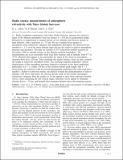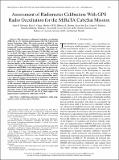Radio science measurements of atmospheric refractivity with Mars Global Surveyor
Author(s)
Cahoy, Kerri; Hinson, David; Tyler, G. Leonard
DownloadCahoy_et_al-2006-Journal_of_Geophysical_Research-_Planets_(1991-2012).pdf (1023.Kb)
Metadata
Show full item recordAbstract
Radio occultation experiments with Mars Global Surveyor measure the refractive index of the Martian atmosphere from the surface to ~250 km in geopotential height. Refractivity is proportional to neutral density at low altitudes and electron density at high altitudes, with a transition at ~75 km. We use weighted least squares to decompose zonal refractivity variations into amplitudes and phases for observed wave numbers k=1-4 over the entire altitude range and use the results to analyze atmospheric structure and dynamics. The data set consists of 147 refractivity profiles acquired in December 2000 at summer solstice in the Martian northern hemisphere. The measurements are at an essentially fixed local time (sunrise) and at latitudes from 67deg to 70degN. Thermal tides appear to be responsible for much of the observed ionospheric structure from 80 to 220 km. Tides modulate the neutral density, which in turn, controls the height at which the ionosphere forms. The resulting longitude-dependent vertical displacement of the ionosphere generates distinctive structure in the fitted amplitudes, particularly at k=3, within plusmn50 km of the electron density peak height. Our k=3 observations are consistent with an eastward propagating semidiurnal tide with zonal wave number 1. Relative to previous results, our analysis extends the characterization of tides to altitudes well above and below the electron density peak. In the neutral atmosphere, refractivity variations from the surface to 50 km appear to arise from stationary Rossby waves. Upon examining the full vertical range, stationary waves appear to dominate altitudes below ~75 km, and thermal tides dominate altitudes above this transition region.
Date issued
2006-05-20Department
Space Telecommunications Astronomy and Radiation (STAR) Lab; Massachusetts Institute of Technology. Department of Aeronautics and AstronauticsPublisher
American Geophysical Union
Citation
Cahoy, K.L., et al. "Radio Science Measurements of Atmospheric Refractivity with Mars Global Surveyor." Journal of Geophysical Research-Part E-Planets, vol. 111, no. E5, 20 May 2006. EBSCOhost, doi:DOI: 10.1029/2005JE002634.
Keywords
radio occultation experiments, Mars Global Surveyor, atmospheric refractive index, Martian atmosphere, geopotential height, neutral density, electron density, zonal refractivity variations, wave numbers, atmospheric structure, atmospheric dynamics, AD 2000 12, Martian northern hemisphere, thermal tides, ionospheric structure, ionosphere forms, neutral atmosphere, stationary Rossby waves
Collections
Related items
Showing items related by title, author, creator and subject.
-
Assessment of Radiometer Calibration With GPS Radio Occultation for the MiRaTA CubeSat Mission
Marinan, A. D.; Cahoy, K. L.; Bishop, R. L.; Lui, S. S.; Bardeen, J. R.; e.a. (Institute of Electrical and Electronics Engineers, 2016-12)The microwave radiometer technology acceleration (MiRaTA) is a 3U CubeSat mission sponsored by the NASA Earth Science Technology Office. The science payload on MiRaTA consists of a triband microwave radiometer and global ... -
12.815 Atmospheric Radiation, Fall 2005
Prinn, Ronald G.; McClatchey, R. A. (2005-12)Introduction to the physics of atmospheric radiation and remote sensing including use of computer codes. Radiative transfer equation including emission and scattering, spectroscopy, Mie theory, and numerical solutions. ... -
12.800 Fluid Dynamics of the Atmosphere and Ocean, Fall 2003
Hansen, James A. (2003-12)This class introduces fluid dynamics to first year graduate students. The aim is to help students acquire an understanding of some of the basic concepts of fluid dynamics that will be needed as a foundation for advanced ...
